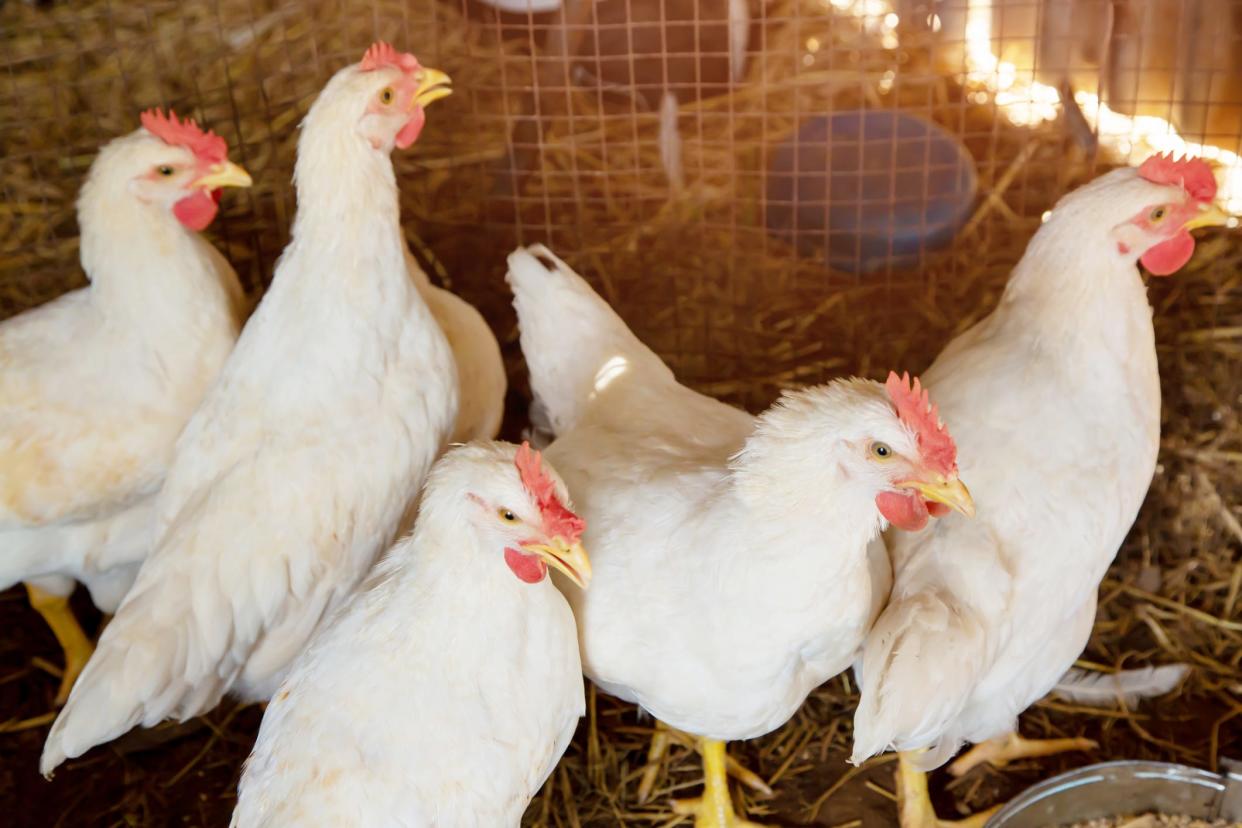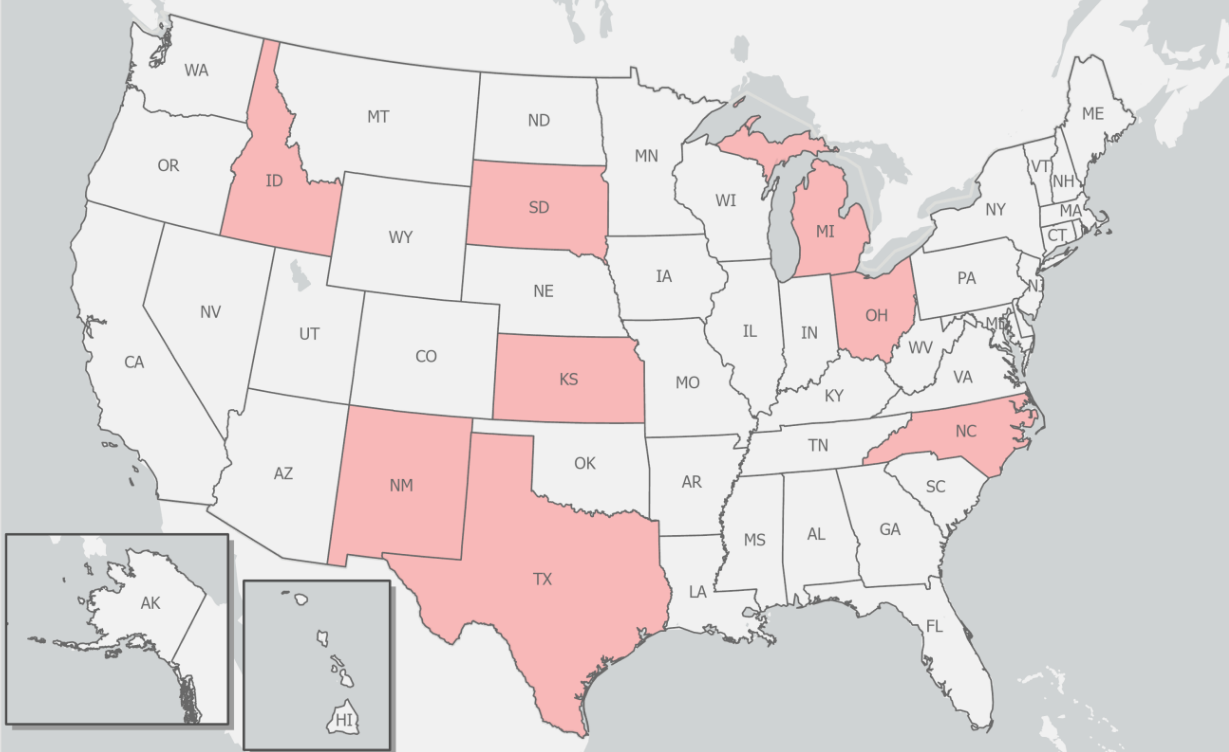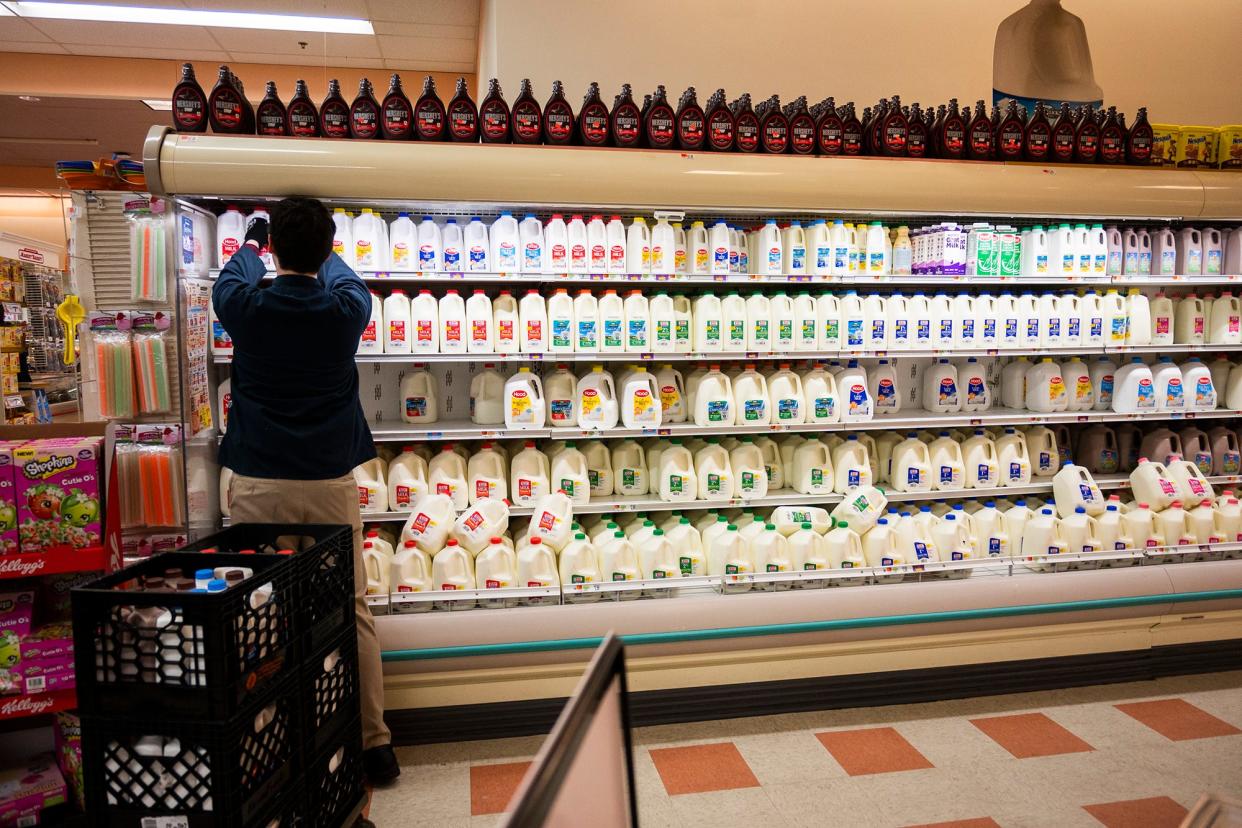Avian flu has spread to cows, milk — and experts worry human outbreak could be next
Avian influenza has raged through Michigan's bird population for two years, forcing commercial farmers and people with backyard coops to kill more than 6.6 million infected chickens and turkeys in about two dozen counties across the state — all with the hope of slowing the spread of the highly pathogenic H5N1 virus.
But so far, culling infected flocks hasn't been enough to curtail the assault from the virus, which was identified Wednesday in another Michigan commercial poultry facility, according to the Michigan Department of Agriculture and Rural Development. This time, it's in Gratiot County. A news release did not provide other details about the facility.
The U.S. Centers for Disease Control and Prevention, the U.S. Food and Drug Administration and the U.S. Department of Agriculture have all said the risk to humans is low — even though H5N1 viral particles were detected in the commercial pasteurized milk supply.
What's most concerning to public health experts is that it isn't only birds that have been infected by the H5N1 virus. It's spreading in cows — eight U.S. states, including Michigan, have known bovine cases — and the virus has been detected in other mammals, too, such as seals and foxes, raccoons and skunks. In two cases in other states, people have gotten sick.

"To date, this strain of avian influenza has not been associated with significant disease in humans," said Dr. Kim Dodd, director of the Michigan State University Veterinary Diagnostic Laboratory.
The virus doesn't appear to spread easily from animals to people. Both human cases in the U.S., which occurred in Colorado and Texas, were among farm workers who handled sick animals, said Dodd, whose lab is part of the National Animal Health Laboratory Network, which she described as "the first line of defense in the case of an incursion of a high consequence, the animal disease or avian disease like H5N1 avian influenza."
But still, she said, "identifying highly pathogenic avian influenza in cattle populations was unexpected. We are learning a lot as we go forward."
Avian flu sparks new pandemic concerns
With the coronavirus pandemic so fresh in public consciousness, there's fear that this avian influenza virus could mutate in a way that would allow it to more readily spill over from animals to people, and then potentially from person to person — triggering another deadly viral scourge.
"When you start to see it in multiple birds, that's a concern. When it gets to multiple mammals, that's getting pretty worrisome. And now that it's in our broad-scale commercial system with milk, we've got increasing touchpoints with the human-animal interface and opportunities for zoonotic spillover," said Timothy Cernak, an assistant professor of chemistry and medicinal chemistry at the University of Michigan.
"I really want to stress that if avian flu breaks out in humans, it could be a lot worse than COVID. The fatality rates are much, much higher."
Cernak pointed to the high bird flu mortality rate in people from Cambodia who were infected with a different subtype of the H5N1 virus than what's currently circulating in the U.S. Of 64 people who contracted the virus from 2003-2023 in Cambodia, 41 died, according to the World Health Organization.
"That's not the strain that's here," Cernak said, but "you can imagine that is not something we want to deal with."

Cernak's work centers on using artificial intelligence to develop a new antiviral drug that would be effective in stopping a potential avian flu outbreak.
"The avian influenza strains that were circulating late last year were pretty resistant to our current antiviral drugs," Cernak said. "What that means is that if we had a breakout, we wouldn't have great tools in hospitals to deal with that.
"The good news is, we know a lot about antivirals. We know a lot about how to make drugs and AI is really an awesome tool to accelerate that."
How sick does the current strain of bird flu make people?
The H5N1 strain that jumped from birds to cows and then to people is the subtype 2.3.4.4b, according to the CDC.
Scientists refer to it as being "highly pathogenic." What that means, Dodd said, is that this particular variation of bird flu is especially deadly for chickens, turkeys, geese and ducks that are raised for the production of meat or eggs for the food supply.
It does not, however, mean the virus causes severe illness or death in other animals or humans.
The two people with known cases of H5N1 bird flu in the U.S. had very mild illnesses, the CDC reported:
A Texas farm worker who was exposed to sick cows in March had only one symptom: eye redness consistent with conjunctivitis. The person was treated with an antiviral flu drug, was asked to isolate to prevent potentially spreading the virus, and recovered.
In April 2022, a Colorado farm worker who culled poultry suspected of being infected with the H5N1 flu virus reported feeling fatigue for several days. The person tested positive for the virus and was isolated and also treated with a flu antiviral drug.
“To date, this strain of avian influenza has not been associated with significant disease in humans," Dodd said.

“In the case of the dairy cows, we know that there was one individual working closely with infected cattle who did develop a little bit of conjunctivitis. There's a lot of work ongoing to perform surveillance on individuals who work closely with some of the infected animals.
"And to date, we don't have any indication that this is causing disease in people. It’s a really important thing to keep in mind: This is low risk for the human population."
The bird flu's leap to mammals
In May 2022, H5N1 was first detected in red foxes in Michigan, Minnesota, Iowa, New York, Alaska and Wisconsin. It's possible they ate the carcasses of birds that had died from avian influenza, Dodd said, and got infected.
Bobcats in Wisconsin, opossums in Iowa and bottle-nosed dolphins in Florida also were sickened by bird flu in 2022, according to the USDA.
Then came raccoons in Washington and skunks in Idaho. Harbor seals and gray seals in Maine got sick, as did grizzly and Kodiak bears, polar bears and black bears in Alaska.
It killed elephant seals in Argentina, and infected Antarctic penguins.
But it wasn't until late 2023 when the H5N1 virus was likely transmitted for the first time from a bird to a cow, according to Dr. Michael Worobey, an evolutionary biologist at the University of Arizona, who worked with others this month to analyze the genetic sequences of the H5N1 virus.
He wrote on X, the social media platform formerly known as Twitter, that there is a "strong possibility that this has been circulating in cattle for months under our noses, even before the first inkling there might be something new in February. This reveals massive gaps in our pathogen surveillance and detection systems."
Though Worobey's work suggests bird flu was spreading in cows in late 2023, the first known dairy cattle H5N1 infections weren't reported by the USDA until March 25, when the agency said it had identified cases in Texas and Kansas.
A few days later the Michigan Department of Agriculture and Rural Development announced that asymptomatic cows from Texas had brought the bird flu to a Montcalm County farm.
"Further testing and investigation by state and federal officials have revealed the source of infection," MDARD said in a news release at the time. "The farm recently received cattle from an affected premises in Texas before that herd showed any sign of disease. When the cattle were moved from Texas to Michigan, the cattle were not symptomatic and did not appear ill."
The cows that were sick had decreased lactation and low appetite. Farmers were instructed to isolate the cows, minimize their exposure to visitors and to prevent them from contact with other animals and wildlife.
But despite the precautions, the virus continued to spread. MDARD reported that H5N1 now has infected dairy cattle from Ionia, Isabella, and Ottawa counties, too, along with seven other states.
And, Dodd said, some barn cats that drank raw milk from sick cows also were infected with bird flu.
Where in Michigan has the bird flu been found in poultry?
The H5N1 virus has been identified in domestic birds from Bay, Branch, Cass, Eaton, Genesee, Gratiot, Ingham, Ionia, Kalamazoo, Lapeer, Livingston, Macomb, Menominee, Montmorency, Muskegon, Newaygo, Oakland, Ottawa, Saginaw, Sanilac, Tuscola, Washtenaw and Wexford counties, according to MDARD.
Is H5N1 flu in the U.S. milk supply?
Yes, but it's not likely to make you sick if you drink pasteurized milk, the FDA says.
Roughly 99% of the nation's milk comes from farms that adhere to the Pasteurized Milk Ordinance, according to the FDA. That ordinance includes safety measures that require milk from sick cows to either be diverted or destroyed; it isn't used in the commercial milk supply. Additionally, milk must undergo pasteurization, which uses heat to deactivate viruses and harmful bacteria.
Still, the FDA announced earlier this week that it detected fragments of the H5N1 virus in the commercial pasteurized milk supply, and pledged to continue investigating.
Authorities used quantitative polymerase chain reaction (qPCR) testing, which can detect viral DNA particles, but does not identify whether those bits of DNA are capable of replicating or causing disease.
"Because qPCR findings do not represent actual virus that may be a risk to consumers, the FDA is further assessing any positive findings," the agency said in a statement issued Tuesday. "To date, we have seen nothing that would change our assessment that the commercial milk supply is safe.

"Based on available information, pasteurization is likely to inactivate the virus, however the process is not expected to remove the presence of viral particles. Therefore, some of the samples collected have indicated the presence of (highly pathogenic avian influenza) HPAI."
Dr. Lea Monday, an infectious diseases physician at the Detroit Medical Center, said drinking pasteurized milk remains safe.
"The virus remnants that were found in the pasteurized milk are just pieces of H5N1 DNA," said Monday, who added that she and her children continue to drink pasteurized milk and and eat cheese products made with pasteurized milk. "It's broken down virus remnants, but not actual live virus. ... People don't have to worry about getting bird flu through cow's milk if they're drinking it, and it's pasteurized."
Health officials warn: Don't drink raw milk
"It's really important for people to realize that although there's no documented evidence of someone getting sick with H5N1 from drinking raw milk, if it hasn't been pasteurized, it could have viral particles that could potentially be infectious," Monday said.
"And there are other things that could be passed to you through raw milk like listeria and brucella that cause very dangerous infections that have extremely high rates of mortality. Listeria causes stillbirth and miscarriage and death. So that's another reason we should not be consuming raw, unpasteurized dairy products."
Is it safe to eat beef and poultry?
The USDA says the nation's meat supply is safe. Animals are inspected prior to slaughter to ensure sick livestock do not enter the food supply.
However, Dodd said it's important to thoroughly cook eggs, poultry and beef to kill off any bacteria or viruses in chicken, duck, goose, turkey or beef.
"At this point, there is no indication of detection of highly pathogenic avian influenza in muscle or meat," she said. "And again, I say that is to this point. I don't have reason to expect that is going to change."
How worried should I be about H5N1 becoming more infectious?
"I think the average American should not be overly concerned about their personal risk at this moment," said Aubree Gordon, a professor or epidemiology and global public health at the University of Michigan. She also is director of the Michigan Center for Infectious Disease Threats and Pandemic Preparedness.
However, she said, there ought to be scrutiny about whether U.S. public health agencies are doing enough to identify the true scope of avian influenza's spread.
"There were a lot of lessons that we certainly should have learned during the COVID-19 pandemic and some of the prior pandemics," Gordon said, "especially in making sure there's enough surveillance going on.
"The dairy industry has a lot of power. It has a lot of money. I do think it's really critical at this moment that the situation is extremely carefully monitored and that there's a lot of surveillance so that we know what's happening."

One of her biggest fears is that the H5N1 virus will begin to infect pigs.
"Pigs can be a bit of a mixing vessel for flu," Gordon said. "They have some of the same receptors that humans have and a virus that transmits well amongst pigs may transmit well amongst humans."
She suggested the USDA should carefully monitor swine for avian influenza infections and public health authorities ought to consider PCR testing of people who have flu-like symptoms.
"There’s been a shift toward rapid testing for flu, and I’m concerned about that with H5N1 emerging," Gordon said. Rapid tests can't differentiate which strain of the flu a person might be carrying, whereas a PCR test sample could be used to identify bird flu.
"A little more testing — testing with a PCR — might be merited, particularly in areas where there are a lot of cows."
What is being done to stop the spread of avian influenza?
The USDA announced tighter restrictions Wednesday on dairy cattle to prevent the spread of H5N1.
Among the new rules, which take effect Monday, cows must first test negative for influenza A viruses and meet USDA conditions for interstate travel before they can be transported over state lines. If cows test positive for the virus, farmers must provide information to help authorities trace their movement from state to state.
In addition, labs and veterinarians will be required to report positive influenza A tests in livestock. The USDA also has a list of biosecurity recommendations for livestock and poultry.
To report sick or dead domestic birds, call the Michigan Department of Agriculture and Rural Development at 800-292-3939.
Contact Kristen Shamus: kshamus@freepress.com. Subscribe to the Free Press.
This article originally appeared on Detroit Free Press: H5N1 avian flu spreads from birds to cows, US milk, humans
